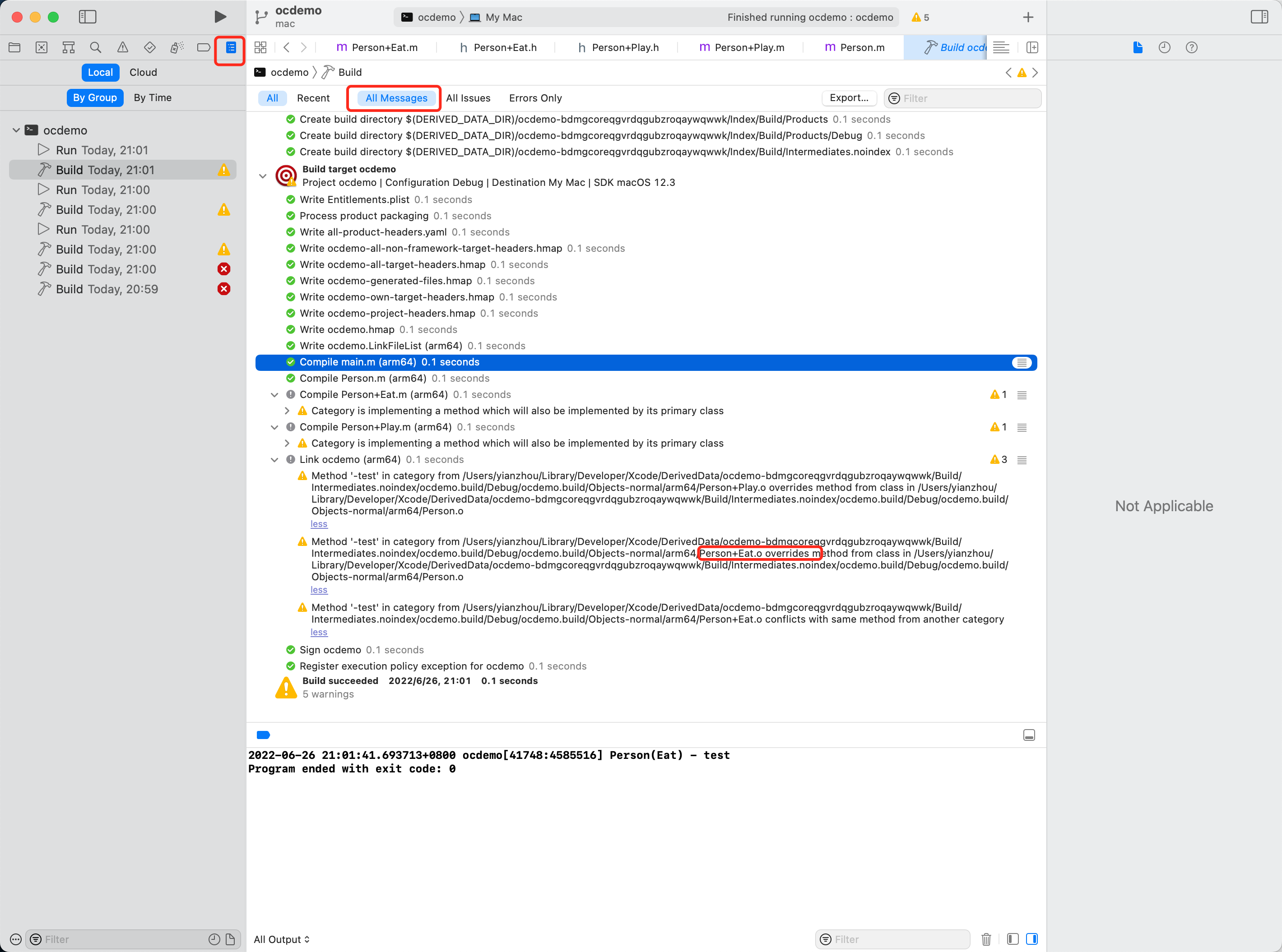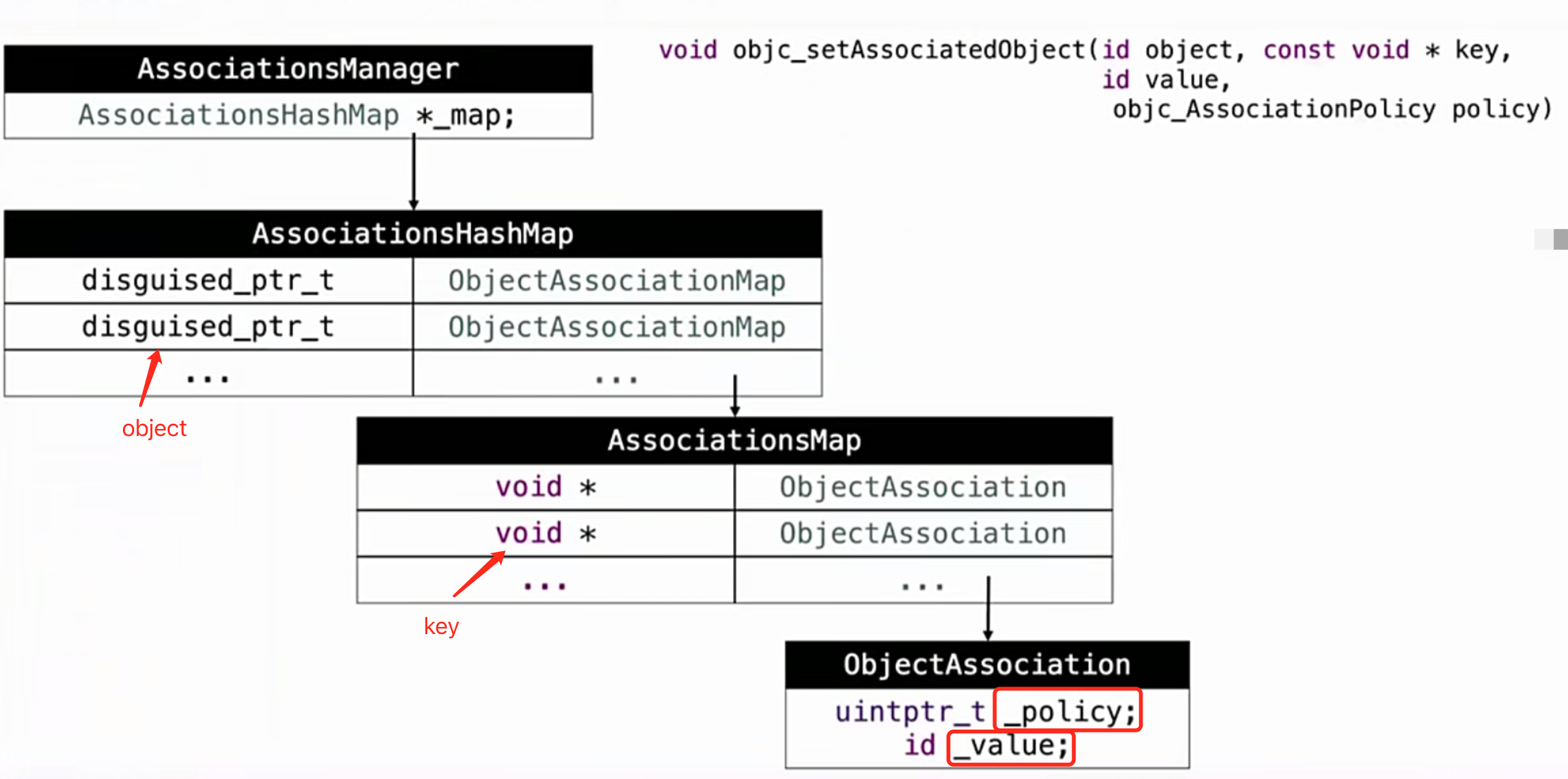Category
怎么扩展已有的类呢?一般而言,继承和组合是不错的选择。但是在 Objective-C 2.0 中,又提供了 category 这个语言特性,可以动态地为已有类添加新行为。
实现原理
新建 Person 类,再新建 Person+Eat 分类,将分类实现文件重写为 cpp 文件,可以找到名为 _category_t 的结构体。这个结构体定义在 objc-runtime-new.h 文件中。
struct _category_t {
const char *name; // 类的名字
struct _class_t *cls;
const struct _method_list_t *instance_methods; // 实例方法列表
const struct _method_list_t *class_methods; // 类方法列表
const struct _protocol_list_t *protocols; // 分类遵循的协议列表
const struct _prop_list_t *properties; // 分类的属性列表
};
可以看出,category 可以添加实例方法,类方法,甚至可以实现协议,添加属性;但无法添加成员变量。
编译后的类,其内存布局已经确定,不能向编译好的类添加实例变量。
运行时创建的类,可以调用
class_addIvar添加成员变量。
并且,在 cpp 文件里定义了一个类型为 struct _category_t、名称为 _OBJC_$_CATEGORY_Person_$_Eat 的变量,并进行了初始化:
static struct _category_t _OBJC_$_CATEGORY_Person_$_Eat __attribute__ ((used, section ("__DATA,__objc_const"))) =
{
"Person",
0, // &OBJC_CLASS_$_Person,
(const struct _method_list_t *)&_OBJC_$_CATEGORY_INSTANCE_METHODS_Person_$_Eat,
0,
0,
0,
};
在编译阶段,每个分类实现文件��,会先以这个结构体的形式参与编译。在运行时,再将这个结构体的数据,加到类对象、元类对象里。怎么添加的呢?
void _objc_init(void) // 这个函数可以看作是加载程序和运行时的入口
{
_dyld_objc_notify_register(&map_images, load_images, unmap_image); // `load_images` 是一个函数的地址
}
void load_images(const char *path __unused, const struct mach_header *mh)
{
if (!didInitialAttachCategories && didCallDyldNotifyRegister) {
didInitialAttachCategories = true;
loadAllCategories();
}
// 附加 category 到类的工作会先于 `+load` 方法的执行。
// 因此在类的 `+load` 方法调用的时候,可以调用 category 中声明的方法。
call_load_methods();
}
static void loadAllCategories() {
load_categories_nolock(hi);
}
static void load_categories_nolock(header_info *hi) {
attachCategories(cls, &lc, 1, ATTACH_EXISTING);
}
// 假设 Person 类有两个分类 Play 和 Eat,那么这里传参就是
// cls: Person
// cats_list: [Play, Eat]
static void attachCategories(Class cls, const locstamped_category_t *cats_list, uint32_t cats_count, int flags)
{
// 这里看源码注释,解释了为什么用长度为 64 的数组
constexpr uint32_t ATTACH_BUFSIZ = 64;
method_list_t *mlists[ATTACH_BUFSIZ]; // 二维数组
/** 数组的内容:
[
[-play1, -play2], // Play 分类的方法列表
[-eat1, -eat2], // Eat 分类的方法列表
]
*/
uint32_t mcount = 0; // 一共加了多少方法
auto rwe = cls->data()->extAllocIfNeeded(); // cls->data()取到类的数据,即class_rw_t
for (uint32_t i = 0; i < cats_count; i++) {
auto& entry = cats_list[i]; // 取出 category_t
method_list_t *mlist = entry.cat->methodsForMeta(isMeta); // 取出分类中的方法
if (mlist) {
if (mcount == ATTACH_BUFSIZ) { // 这里处理的是一个类超过64个分类的情况
prepareMethodLists(cls, mlists, mcount, NO, fromBundle, __func__);
rwe->methods.attachLists(mlists, mcount);
mcount = 0;
}
// 将方法加到二维数组里:
// 先进循环的分类,其方法放在数组的后面位置;
// 后进循环的分类,其方法放在数组的前面位置;
// 所以,最后链接的分类,其 image 中的方法,会在最前面。
mlists[ATTACH_BUFSIZ - ++mcount] = mlist;
}
}
if (mcount > 0) {
prepareMethodLists(cls, mlists + ATTACH_BUFSIZ - mcount, mcount,
NO, fromBundle, __func__);
// 将二维数组里的所有方法,加到类的方法列表里,即 class_rw_t 里的 methods
rwe->methods.attachLists(mlists + ATTACH_BUFSIZ - mcount, mcount);
}
}
// addedLists: 上面那个二维数组
// addedCount: 上面那个二维数组里的方法数
class list_array_tt {
void attachLists(List* const * addedLists, uint32_t addedCount) {
if (addedCount == 0) return;
if (hasArray()) {
// many lists -> many lists
uint32_t oldCount = array()->count;
uint32_t newCount = oldCount + addedCount;
array_t *newArray = (array_t *)malloc(array_t::byteSize(newCount));
newArray->count = newCount;
array()->count = newCount;
// array()->lists 是原来的方法列表,放到新数组的后面位置
for (int i = oldCount - 1; i >= 0; i--)
newArray->lists[i + addedCount] = array()->lists[i];
// addedLists 是新加的方法列表,放在新数组的前面位置
for (unsigned i = 0; i < addedCount; i++)
newArray->lists[i] = addedLists[i];
// 假设原来 Person 类有方法 A, B
// 先链接 Play 分类的方法 C, D
// 后链接 Eat 分类的方法 E, F
// 则新数组为 E, F, C, D, A, B
free(array());
setArray(newArray);
validate();
}
}
}

这里我们可以看到,Person+Eat.o 最后被链接,因此同名方法里,调用的是 Eat 分类的方法。
类扩展
@interface Person ()
Class Extension(类扩展,也叫匿名分类),是在编译阶段就直接与 Person 类合并在一起,编译到 Person.o 文件里的。
class extensions are often referred to as anonymous categories
extension 可以添加成员变量,category 不能。
load
+load 和其它类方法一样,都是放在元类对象的方法列表里。
Category 也可以有+load方法。
我们一般不会主动去调用,而是在 Runtime 加载类、分类时由系统来调用,且程序运行过程中只调用一次。
调用过程:
void prepare_load_methods(const headerType *mhdr)
{
classref_t const *classlist = _getObjc2NonlazyClassList(mhdr, &count); // 这里的顺序就和编译顺序有关了
for (i = 0; i < count; i++) {
schedule_class_load(remapClass(classlist[i]));
}
category_t * const *categorylist = _getObjc2NonlazyCategoryList(mhdr, &count); // 这里的顺序就和编译顺序有关了
for (i = 0; i < count; i++) {
add_category_to_loadable_list(cat);
}
// 结论:先编译的分类先调用,跟分类所属的类没关系
}
static void schedule_class_load(Class cls)
{
// Ensure superclass-first ordering
// 递归调用自身,也就是说,先将父类的方法放到数组里
// 结论:先调用父类的 +load 方法,再调用子类的 +load 方法
schedule_class_load(cls->getSuperclass());
add_class_to_loadable_list(cls);
}
void call_load_methods(void)
{
// 结论:先调用类的 +load 方法,再调用分类的 +load 方法
do {
// 1. Repeatedly call class +loads until there aren't any more
while (loadable_classes_used > 0) {
call_class_loads();
}
// 2. Call category +loads ONCE
more_categories = call_category_loads();
// 3. Run more +loads if there are classes OR more untried categories
} while (loadable_classes_used > 0 || more_categories);
}
static void call_class_loads(void)
{
// 直接拿到 +load 方法的指针来调用,不是通过 objc_msgSend
// 结论:类的 +load 并不会被分类的 +load 方法所覆盖
load_method_t load_method = (load_method_t)classes[i].method;
(*load_method)(cls, @selector(load));
}
initialize
+initialize 会在类第一次接收到消息发送时调用,最常��见的就是 +alloc 方法,如 [NSObject alloc]。
要想调用 alloc 方法,类对象会先通过 isa 指针找到元类对象,进而查找方法列表,我们可以看 class_getClassMethod 的源码:
Method class_getClassMethod(Class cls, SEL sel)
{
// 之前已经学习过,元类对象和类对象的数据结构一模一样,元类对象就是特殊的类对象
// 因此找元类对象的方法列表,就是将元类对象传参给 class_getInstanceMethod 方法
return class_getInstanceMethod(cls->getMeta(), sel);
}
Method class_getInstanceMethod(Class cls, SEL sel)
{
// Search method lists, try method resolver, etc.
lookUpImpOrForward(nil, sel, cls, LOOKUP_RESOLVER);
return _class_getMethod(cls, sel);
}
NEVER_INLINE
IMP lookUpImpOrForward(id inst, SEL sel, Class cls, int behavior)
{
cls = realizeAndInitializeIfNeeded_locked(inst, cls, behavior & LOOKUP_INITIALIZE);
}
static Class realizeAndInitializeIfNeeded_locked(id inst, Class cls, bool initialize)
{
if (slowpath(initialize && !cls->isInitialized())) {
cls = initializeAndLeaveLocked(cls, inst, runtimeLock);
}
return cls;
}
static Class initializeAndLeaveLocked(Class cls, id obj, mutex_t& lock)
{
return initializeAndMaybeRelock(cls, obj, lock, true);
}
static Class initializeAndMaybeRelock(Class cls, id inst, mutex_t& lock, bool leaveLocked)
{
initializeNonMetaClass(nonmeta);
}
/***********************************************************************
* class_initialize. Send the '+initialize' message on demand to any
* uninitialized class. Force initialization of superclasses first.
**********************************************************************/
void initializeNonMetaClass(Class cls)
{
Class supercls;
// Make sure super is done initializing BEFORE beginning to initialize cls.
// See note about deadlock above.
supercls = cls->getSuperclass();
if (supercls && !supercls->isInitialized()) {
// 结论:如果父类没有初始化,强制先调用父类的初始化
initializeNonMetaClass(supercls); // 递归
}
callInitialize(cls);
}
void callInitialize(Class cls)
{
// 结论:走的 objc_msgSend
// 因此:
// 1. 如果分类实现了 +initialize,会覆盖类的 +initialize 的实现
// 2. 如果子类没有实现 +initialize,在向子类发送此消息时,会找到父类的 +initialize 方法并调用,所以 +initialize 是可能被调用多次的!
((void(*)(Class, SEL))objc_msgSend)(cls, @selector(initialize));
}
验证:
// @interface Person : NSObject
// @interface Student : Person
#import "Student.h"
int main(int argc, const char * argv[]) {
[Student alloc];
return 0;
}
/**
2012-07-02 16:31:45.442989+0800 ocdemo[21209:5122958] Person(Eat) +initialize
// 由于父类没有初始化过,先调用父类的初始化方法:objc_msgSend(objc_getClass("Person"), @selector(initialize))
2012-07-02 16:31:45.443267+0800 ocdemo[21481:5125042] Person(Eat) +initialize
// 父类已经初始化过了,调用子类的初始化方法:objc_msgSend(objc_getClass("Student"), @selector(initialize))
// 但由于子类没有实现 +initialize,因此消息发送机制又找到了父类的 +initialize 来调用
*/
关联对象
在分类里面写一个属性,编译器只会生成 get 和 set 方法的声明,不会为我们生成成员变量、get 和 set 方法的实现!
@interface Student (Name)
@property(nonatomic, copy) NSString* name;
/**
- (NSString *)name;
- (void)setName:(NSString *)name;
*/
@end
Xcode 会有警告:
Property 'name' requires method 'name' to be defined - use @dynamic or provide a method implementation in this category
原因是编译后对象的内存布局已经确定,如果在运行时添加实例变量就会破坏类的内存布局,这对编译型语言是灾难性的。所以需使用关联对象为已存在的类添加属性。
关联对象的 Key 最好用 @selector 来实现,1. 代码简洁,不用另外声明变量;2. 编译器有检查,@selector 的方法必须存在,因此不会写错。
#import "objc/runtime.h"
@implementation Student (Name)
- (NSString *)name {
// 对于 get 方法,还可以写成 `objc_getAssociatedObject(self, _cmd)`,`_cmd` 表示当前方法的 selector
return objc_getAssociatedObject(self, @selector(name));
}
- (void)setName:(NSString *)name {
objc_setAssociatedObject(self, @selector(name), name, OBJC_ASSOCIATION_COPY_NONATOMIC);
}
@end
DenseMap 与 DisguisedPtr
DenseMap 是在 llvm 中用的非常广泛的数据结构,它的实现是一个基于二次探测的哈希表。其中哈希逻辑抽象到了 DenseMapBase 中,而内存管理的逻辑留在了 DenseMap 和 SmallDenseMap 实现。
二次探测(Quadratic Probing)是一种解决哈希冲突的方法,当发生冲突时,算法会根据一个二次函数来计算下一个探测位置。
DisguisedPtr 在底层很常用,它直译为伪装指针:
class DisguisedPtr {
// typedef unsigned long uintptr_t;
uintptr_t value;
static uintptr_t disguise(T* ptr) {
return -(uintptr_t)ptr; // 将指针地址值直接取反
}
static T* undisguise(uintptr_t val) {
return (T*)-val;
}
}
关联对象的存储
所有实例的关联对象,都存在 Runtime 维护的全局哈希表中。key 是实例对象的内存地址(经过伪装),value 是关联对象的 KV 字典。

调用过程:
void objc_setAssociatedObject(id object, const void *key, id value, objc_AssociationPolicy policy)
{
_object_set_associative_reference(object, key, value, policy); // 这四个参数不用解释了,一看就知道是什么
}
typedef DenseMap<const void *, ObjcAssociation> ObjectAssociationMap;
typedef DenseMap<DisguisedPtr<objc_object>, ObjectAssociationMap> AssociationsHashMap;
class AssociationsManager {
using Storage = ExplicitInitDenseMap<DisguisedPtr<objc_object>, ObjectAssociationMap>;
static Storage _mapStorage;
AssociationsHashMap &get() {
return _mapStorage.get();
}
};
void _object_set_associative_reference(id object, const void *key, id value, uintptr_t policy)
{
DisguisedPtr<objc_object> disguised{(objc_object *)object}; // 伪装指针,并不会增加 object 的引用计数
ObjcAssociation association{policy, value};
association.acquireValue(); // 执行 retain 或 copy 操作
{
AssociationsManager manager;
AssociationsHashMap &associations(manager.get());
// 根据 value 是否为空进行不同的操作
if (value) { // 设置关联对象
// try_emplace 是 std::map 的方法,尝试放置键值对,返回值是 pair<iterator, bool>
// try_emplace 方法会尝试插入,如果键已经存在,则不会插入
// `ObjectAssociationMap{}` 构建了一个新的 `ObjectAssociationMap`
auto refs_result = associations.try_emplace(disguised, ObjectAssociationMap{});
/* establish or replace the association */
auto &refs = refs_result.first->second; // 获取到 `ObjectAssociationMap`
auto result = refs.try_emplace(key, std::move(association));
if (!result.second) { // 说明key已经存在
association.swap(result.first->second); // 用`association`替换已有的值
}
} else { // 关联对象置空
auto refs_it = associations.find(disguised);
if (refs_it != associations.end()) {
auto &refs = refs_it->second;
auto it = refs.find(key);
if (it != refs.end()) {
association.swap(it->second);
refs.erase(it);
if (refs.size() == 0) {
associations.erase(refs_it);
}
}
}
}
}
}
如何调用被分类覆盖的方法
拿到类对象 -> 拷贝方法列表 -> 方法名称匹配(先匹配到 category 的方法,后匹配到类的方法)拿到排在后面的 SEL 和 IMP。
Student* student = [[Student alloc] init];
student.gender = @"M";
// Student 的 printGender 方法已被 category Student (Name) 覆盖
Class studentClass = [Student class];
if (studentClass) {
unsigned int methodCount;
Method *methodList = class_copyMethodList(studentClass, &methodCount);
IMP lastIMP = NULL;
SEL lastSel = NULL;
for (int i = 0; i < methodCount; i++) {
Method method = methodList[i];
NSString *methodName = [NSString stringWithCString:sel_getName(method_getName(method)) encoding:NSUTF8StringEncoding];
if ([@"printGender" isEqualToString:methodName]) {
lastIMP = method_getImplementation(method);
lastSel = method_getName(method);
}
}
// 见 objc 源代码 message.h
// * These functions must be cast to an appropriate function pointer type
// * before being called.
// 这些方法需要强制转换成适当的函数指针类型才能调用
typedef void (*fn)(id, SEL);
if (lastIMP != NULL) {
fn f = (fn)lastIMP;
f(student, lastSel);
}
free(methodList);
}